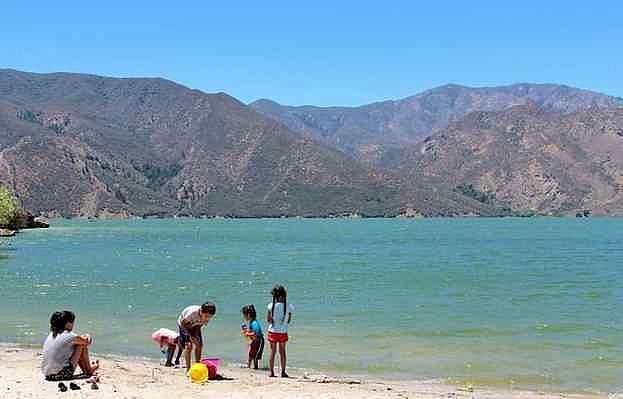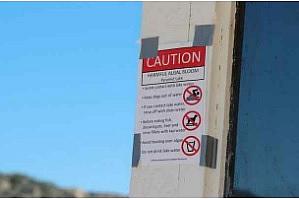People got sick at Pyramid Lake before the state reported toxic algae bloom. Could it have been avoided?
This article was produced as a project for the California Data Fellowship, a program of the Center for Health Journalism at the USC Annenberg School for Communication and Journalism.
Other stories in the series include:
What’s being done to assess blue-green algae’s risk to humans
Wading into danger: Growth of toxic algae could make California's lakes unsafe?
What’s being done to assess blue-green algae’s risk to humans
Toxic algae is blooming more often in our lakes, reservoirs. Does that threaten our drinking water?

Children play near the shore at Pyramid Lake in Los Angeles County on Friday. Multiple people have reported getting sick after being exposed to a toxic algal bloom there.
After watching her 13-year-old son throw up everything he ate when they got home from a day of jet skiing at Pyramid Lake, Sharyn Martinez was angered to learn last week that the state is now urging the public to avoid the water there because of a toxic algal bloom.
Martinez and her family were at the Los Angeles County reservoir on July 9. Days later, the department notified the public about the bloom.
“To find out after the fact that this could have been avoided — you put my kid through a little nightmare here and you affected his health,” said Martinez, 45, of Lakewood, who is certain the toxic bloom sickened her son. “They should have, at the very least, given a flier at the gate then we would have at least had the option to turn around.”
A caution sign advises people not to make contact with water at Pyramid Lake in Los Angeles County on Friday. Multiple people have reported getting sick after being exposed to a toxic algal bloom there. Stephanie K. Baer — Southern California News Group
Test results provided by the state Department of Water Resources, which manages recreation at Pyramid Lake, show that unsafe levels of a dangerous toxin produced by cyanobacteria, commonly known as blue-green algae, were detected in water samples collected from the drinking water reservoir on June 28 and July 6, but it wasn’t until July 12 that caution signs were posted at the lake.
As of Monday, the Los Angeles County Department of Public Health received reports about three people falling ill after recreating at the lake between June 17 and July 10. They reported having skin rashes, diarrhea and fatigue, said Terri Williams, director of environmental health for the department.
None of the reports involved people being hospitalized for their symptoms.
DWR staff have said in emails the reason for the delay in notifying the public was they needed to collect additional samples to “determine the extent of the bloom and whether it was increasing or decreasing.”
But according to voluntary guidelines developed by the California Cyanobacteria Harmful Algal Bloom Network, which California’s DWR is a part of, a caution sign warning the public that “harmful algae may be present” should have been posted when the department received the toxin analysis for the June 28 sample on June 30.
A concentration of 4.98 micrograms per liter of microcystin — about 6 times more than the network’s 0.8 micrograms per liter advisory threshold — was detected in that sample, according to DWR. Samples collected on July 6 contained 5.2 micrograms per liter and 26 micrograms per liter of microcystin.
The results of those samples were received on July 12.
“Whether they should have posted the thing sooner, I can’t second guess, but their policy says they should have,” said Wayne Carmichael, a professor emeritus at Ohio’s Wright State University who has studied cyanotoxins for more than 40 years, adding that he understood why the department wanted to wait before posting the advisory. “These numbers go up and down and they’re very sensitive to posting and then not having a real issue.”
Still, Carmichael said he thought the state’s advisory level was a bit low. Vermont and Virginia recommend humans and animals should have no contact with the water when 6 micrograms per liter of microcystin is present. Oregon says 10 micrograms per liter.
Cyanotoxins are known to cause a wide range of adverse health effects, including skin rashes, headaches, diarrhea and fever, but they are not regulated by the U.S. Environmental Protection Agency in recreational water or drinking water supplies.
“I probably got sick from the algae, that’s what it was — there’s no question,” said Newport Beach resident Kelly MacDonald.
MacDonald, 30, said she too wished officials had warned her and her friends about the algal bloom when she visited Pyramid Lake over the Fourth of July weekend.
Within minutes of ingesting water through her nose and mouth while waterskiing she could barely climb up the ladder into her friend’s boat because of a sudden headache that ended up lasting for about three days.
“It was the worst headache I’ve ever had and I suffer from migraines,” MacDonald said. “My whole head was just throbbing.”
Anyone who has fallen ill after going into the water at Pyramid Lake can report their symptoms to the county Department of Public Health at 888-700-9995.
[This story was originally published by SGVT.]
Photos by Stephanie K. Baer/Southern California News Group.

